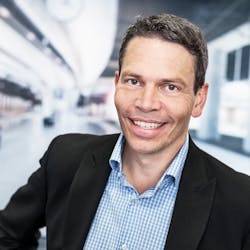Axis Communications continues its tradition of customer-centric solutions
It has been a busy two years at Axis Communications. There have been several new Axis Experience Centers opened around the country. These state-of-the-art technology solutions facilities recently welcomed clients in Manhattan, the Minneapolis/St. Paul metroplex and Houston. Other locations include Boston, Chicago, Dallas, Fort Lauderdale, Los Angeles, San Jose and Washington D.C, along with several around the globe. Then there are the myriad technology partnerships that have emerged as well, including those with Genetec, Pedestal Pro, SecuriThings, Ambient.ai, Wasabi and BriefCam to name but a few.
Through it all, Axis Communications Vice President for the Americas, Fredrik Nilsson, has either shepherded or spearheaded many of the missions of providing clients with cutting-edge technology. I was fortunate to speak to Fredrik prior to the ISC West kickoff about the Axis roadmap and how they see the future.
Steve Lasky: You're probably busier than ever as Axis has experienced the previous mergers and acquisitions and is now driving new partnerships. But you have also been opening new solution centers around the country over the last several months. Tell us a little bit about the newest ones that have opened. What are the solution labs all about and what's the mindset for opening these around the country?
Fredrik Nilsson: Great question. This is a journey that we started back in 2015 and we had a mantra of getting closer to the customers. We had also grown a lot by that point, so we needed to change our organization. We created here in the U.S. what we call the "business areas" that were self-sustaining units close to the customer and used those Experience Centers as a base for them to interact with the customers. We had one here in Chelmsford outside of Boston, back in 2010 when we opened our offices here. We soon realized that a lot of people in North America don't necessarily want to jump on a flight, fly six hours and then drive an hour outside of Boston to see what kind of solutions we have. So, we decided to get closer to the customers and build out teams around those and Experience Centers.
We built out six in the U.S., one in Canada, and one in Latin America over the next couple of years up until 2019. Those got great reviews from our customers, both our end-user partners and system integrators, as well as our technology partners such as Genetec, Milestone, et cetera. We call them Experience Centers because it's not an office. This is a customer-facing Experience Center where our partners can come in and collaborate around solutions, spending time testing different cameras. We have cameras that we can access from across the globe. We have a lot of cameras there, a couple of hundred in the center, some on the rooftop and the like. We can configure the way we want just to try different things out.
It drove a lot of trust. And of course, with that, a lot of business and revenue for us. Being a very growth-oriented company and long-term company, once we moved into COVID, we saw a lot of people decide to play it on the safe side and be at home. We thought that the world would get back to wanting to meet together and build a face-to-face relationship and trust. Especially with our complex technology that is geared towards saving and life and protecting property, it would be important to make the right decision. So, in the COVID situation, we decided instead of locking things down, which we did for a while and limiting ourselves to those eight access Experience Centers, we doubled down.
This is a great concept. Now when many {companies} are struggling with office space or real estate, let's take the opportunity for clients and partners to come to us. Over the last two years, we have opened up eight new facilities, including Minneapolis, and New York and we have Atlanta and a couple of other places in the works. These continue to be great differentiators to demonstrate the Axis value and provide people with the Axis experience. But it also builds that relationship and trust and drives us to use the technology to the absolute best extent we can together with our partners.Lasky: Axis has been a customer-centric company – it is your mantra. It's a great segue into what you're doing with the partnerships. I guess that mindset of bringing the customer as many tentacles of technologies as you can.
Nilsson: We're just one part of the pie. We have the cameras, of course, and now we have the speakers, we have the access control, and we have the intercoms, as well, but we need partners for the cloud solutions like Wasabi. We need partners for the AI, we need partners for managing devices like SecuriThings. And we need partners on the access control side like Genetec. As this has also been our mantra for a long time. One of our core values is “Always Open” and part of that is on the relationship side of the technology. If we want to work with those partners and create solutions that are meaningful to the end customers and the partners, we're going to work closely together because technology is very complex. That's why we’ve spent a lot of time over the last couple of years strengthening those relationships.
Lasky: Your big push as the company was moving towards that tipping point of IP overtaking analog, the focus was IP camera technology and other video solutions. But right now, it looks like the big push is access to the IOT universe.
Nilsson: It's really coming back to our roots. When I started with Axis back in 1996 we had a concept that we called "Thin Server", which actually meant having a small server connected to the internet. Today, we call it IoT. Back in the day, Axis was doing printer connectivity and we told clients we had really cool technology that could connect devices to the network. We decided to launch a storage-connected server, a scanner that was connected to the internet, as well as cameras. That concept eventually generated our entry into the security space and {evolved into} the company we are today. We only focused on cameras from 2005 through 2015 because those were the great days of convergence and moving from analog over to IP. We knew this was the future. We went back to say, what else can we connect to the network?We found access control, we found intercoms, and we found audio that we thought would benefit from being connected to the internet. Then we went back to our old IoT roots…and launched into … all those other devices on a network and managed them from one of the same systems as Genetec or a Milestone. That brought even more value to the end customers. The last couple of years {have been spent| strengthening those portfolios and building those relationships.
Lasky: It's interesting as you talk about keeping an eye on the client and the customer, you haven't forgotten about the systems integrator. At the last GSX Axis introduced a new easy to integrate solution for systems integrators. Talk about how you've kept an eye on the integrator as well.
Fredrik Nilsson: That’s a good point. I would say not only keeping an eye but working extremely closely with them. If you take as an example, the relationship we have with Genetec now, it's not a new relationship, it's a relationship we have refined over the last couple of years and just recently launched a solution called Axis Power by Genetec. In the past, you would have taken our controller with an API, another box from Genetec and their software on top of it. Three different pieces of a solution, which for an integrator was a lot of stuff to make sure it was integrated and working properly. When we sat down with Genetec we asked how can we make this easier for the integrator. We figured the functionality they have in their local box, the cloud link with stronger AI, the stronger chipset on the edge, we could use the containerized version of their firmware and put it into our controller.
In the past we worked with APIs, meaning that we’d create a device with a clear set of APIs and then our partners would integrate towards that. What we've done with Genetec, is for the first time, take part of their software and put it inside of our controller to make it an even easier solution for the integrator to procure, easier to integrate and even more cyber secure. It might sound like a small thing, but it might make a huge difference for a big installation.
About the author: Steve Lasky is a 34-year veteran of the security industry and an award-winning journalist. He is the editorial director of the Endeavor Business Media Security Group, which includes magazines Security Technology Executive, Security Business and Locksmith Ledger International and the top-rated webportal SecurityInfoWatch.com. Steve can be reached at [email protected]
About the Author
Steve Lasky
Editorial Director, Editor-in-Chief/Security Technology Executive
Steve Lasky is Editorial Director of the Endeavor Business Media Security Group, which includes SecurityInfoWatch.com, as well as Security Business, Security Technology Executive, and Locksmith Ledger magazines. He is also the host of the SecurityDNA podcast series. Reach him at [email protected].




